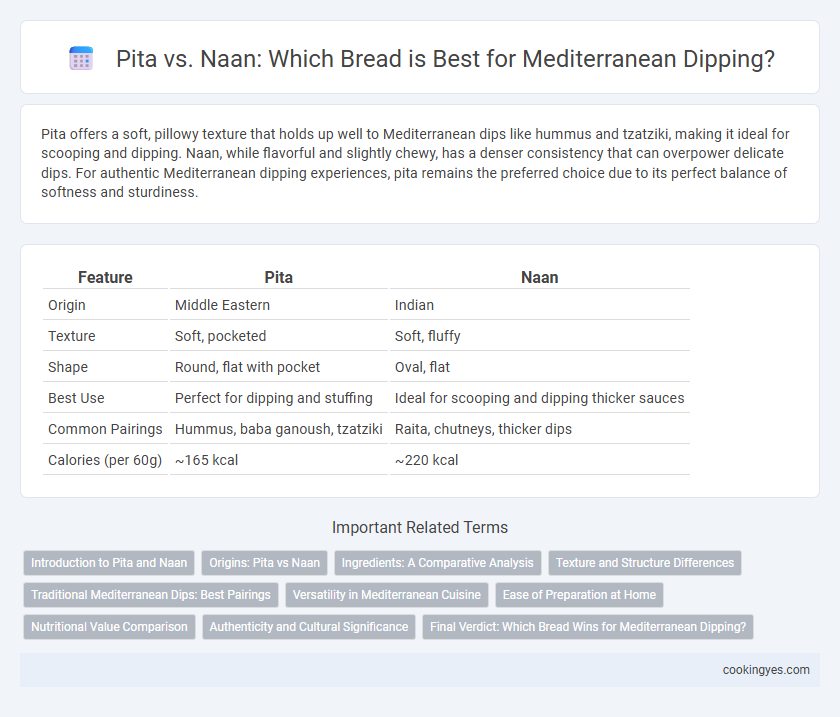Pita offers a soft, pillowy texture that holds up well to Mediterranean dips like hummus and tzatziki, making it ideal for scooping and dipping. Naan, while flavorful and slightly chewy, has a denser consistency that can overpower delicate dips. For authentic Mediterranean dipping experiences, pita remains the preferred choice due to its perfect balance of softness and sturdiness.
Table of Comparison
| Feature | Pita | Naan |
|---|---|---|
| Origin | Middle Eastern | Indian |
| Texture | Soft, pocketed | Soft, fluffy |
| Shape | Round, flat with pocket | Oval, flat |
| Best Use | Perfect for dipping and stuffing | Ideal for scooping and dipping thicker sauces |
| Common Pairings | Hummus, baba ganoush, tzatziki | Raita, chutneys, thicker dips |
| Calories (per 60g) | ~165 kcal | ~220 kcal |
Introduction to Pita and Naan
Pita and naan are both popular flatbreads commonly used in Mediterranean and South Asian cuisines, respectively. Pita is known for its pocket-like structure, making it ideal for dipping and stuffing with Mediterranean spreads such as hummus and baba ganoush. Naan, typically softer and thicker, is often paired with Indian curries but is less commonly used for Mediterranean dipping due to its dense texture.
Origins: Pita vs Naan
Pita, originating from the Mediterranean region, particularly Greece and the Middle East, features a pocket ideal for dipping and stuffing, making it essential in Mediterranean cuisine. Naan, on the other hand, hails from South Asia and is traditionally cooked in a tandoor, resulting in a thicker, fluffier bread less suited for dipping. Understanding these distinct origins highlights how pita's pocketed, thin structure better complements Mediterranean dips like hummus and tzatziki.
Ingredients: A Comparative Analysis
Pita and naan differ significantly in their core ingredients, where pita typically contains simple ingredients like wheat flour, water, yeast, and a pinch of salt, resulting in a lighter and airier texture ideal for Mediterranean dipping. Naan incorporates additional ingredients such as yogurt, milk, and sometimes eggs, which contribute to its richer, softer, and slightly chewy consistency. The absence of dairy in pita makes it a versatile choice for vegan-friendly Mediterranean dips, while naan's richer composition enhances its pairing with creamy or spiced dips.
Texture and Structure Differences
Pita features a soft, chewy texture with a pocketed structure that traps air, making it ideal for dipping in Mediterranean sauces by holding and scooping dips effectively. Naan, thicker and denser with a slightly crispy exterior and a more bread-like crumb, absorbs dips differently but lacks the air pocket flexibility of pita. The contrast in texture and structure between pita's light, airy quality and naan's heavier, robust composition influences their suitability for various Mediterranean dips.
Traditional Mediterranean Dips: Best Pairings
Pita bread's soft, pocketed texture makes it ideal for traditional Mediterranean dips like hummus, baba ganoush, and tzatziki, as it effortlessly scoops and holds the creamy consistencies. Naan, with its denser and thicker structure, pairs better with heartier dips such as spicy harissa or robust olive tapenades, complementing their intense flavors. While both breads enhance Mediterranean dipping experiences, pita's versatility and lightness specifically optimize savoring classic, smooth spreads.
Versatility in Mediterranean Cuisine
Pita offers unmatched versatility in Mediterranean cuisine due to its pocket structure, making it ideal for stuffing with a variety of fillings like falafel, gyro, or hummus for convenient dipping and eating. Unlike naan, which is denser and best paired with saucy dishes, pita's light, airy texture absorbs dips such as tzatziki, baba ganoush, and muhammara more effectively. This adaptability makes pita the preferred bread for a wide range of Mediterranean appetizers and meals centered around communal dipping.
Ease of Preparation at Home
Pita bread offers a significant advantage over naan in ease of preparation at home due to its simple ingredient list and quick baking process, often requiring just basic flour, water, yeast, and salt. Pita's pocket-forming technique is straightforward, enabling it to puff up evenly in a hot oven or on a stovetop, delivering an ideal structure for Mediterranean dipping. In comparison, naan typically demands ingredients like yogurt and ghee, as well as longer fermentation times and specialized cooking methods such as tandoor or skillet use, making pita the more accessible option for homemade Mediterranean appetizers.
Nutritional Value Comparison
Pita bread typically contains fewer calories and less fat compared to naan, making it a lighter option for Mediterranean dipping. Pita is usually lower in carbohydrates and sodium, contributing to a healthier overall nutritional profile. Naan often includes butter or ghee, increasing its saturated fat content and calorie density, which may impact dietary choices for those monitoring fat intake.
Authenticity and Cultural Significance
Pita bread holds authentic roots in Mediterranean cuisine, traditionally baked with a pocket that allows for perfect dipping and scooping of dishes like hummus and baba ganoush. Naan, more commonly linked to South Asian culinary traditions, often incorporates dairy and leavening agents that give it a softer texture, differing from pita's chewy and slightly charred profile essential for Mediterranean dips. The cultural significance of pita in Mediterranean dining is reflected in its ubiquitous presence across meals, symbolizing communal sharing and historical culinary heritage.
Final Verdict: Which Bread Wins for Mediterranean Dipping?
Pita bread wins for Mediterranean dipping due to its soft, pocketed texture that effortlessly holds creamy hummus, tangy tzatziki, and zesty baba ganoush. Unlike naan, which is denser and often brushed with buttery garlic, pita's airy and slightly chewy consistency enhances the dipping experience without overpowering the flavors. The versatility and traditional use of pita in Mediterranean cuisine solidify its status as the superior bread for authentic dipping.
Pita vs Naan for Mediterranean dipping Infographic

 cookingyes.com
cookingyes.com